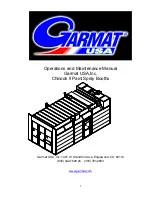
FXAlg #727: PolyD EQ
Algorithm Reference-99
PolyDistort is an unusual distortion algorithm which provides a great number of parameters to build a distortion
sound from the ground up. The eight distortion stages each add a small amount of distortion to the sound. Taken
together, they can produce a very harsh heavy metal sound. Between each distortion stage is a lopass filter. The
lopass filters work with the distortion stages to help mellow out the sound. Without any lopass filters the distortion
will get very harsh and raspy.
Stages of distortion can be removed by setting the Curve parameter to 0. You can then do a 6, 4, or 2 stage distortion
algorithm. The corresponding lopasses should be turned off if there is no distortion in a section. More than 4 stages
seem necessary for lead guitar sounds. For a cleaner sound, you may want to limit yourself to only 4 stages.
Once you have set up a distorted sound you are satisfied with, the Dist Drive parameter controls the input gain to
the distortion, providing a single parameter for controlling distortion amount. You will probably find that you will
have to cut back on the output gain as you drive the distortion louder.
Post-distortion EQ is definitely needed to make things sound right. This should be something like a guitar speaker
cabinet simulator, although not exactly, since we are already doing a lot of lopass filtering inside the distortion itself.
Possible EQ settings you can try are Treble -20 dB at 5 kHz, Bass -6 dB at 100 Hz, Mid1, wide, +6 dB at 2 kHz, Mid2,
wide, +3 dB at 200 Hz, but of course you should certainly experiment to get your sound. The Treble is helping to
remove raspiness, the Bass is removing the extreme low end like an open-back guitar cabinet (not that guitar
speakers have that much low end anyway), Mid1 adds enough highs so that things can sound bright even in the
presence of all the HF roll-off, and Mid2 adds some warmth. Your favorite settings will probably be different.
Boosting the Treble may not be a good idea.
Pre-distortion EQ, available on the KDFX Studio INPUT pages, is also useful for shaping the sound. EQ done in
front of the distortion will not be heard as simple EQ, because the distortion section makes an adjustment in one
frequency range felt over a much wider range due to action of the distortion. Simple post-EQ is a bit too obvious for
the ear, and it can get tiring after a while.
Parameters:
PAGE 1
PAGE 2
PAGE 2
Wet/Dry
0 to 100%wet
Out Gain
Off, -79.0 to 24.0 dB
Dist Drive
Off, -79.0 to 48.0 dB
Curve 1
0 to 127%
Curve 5
0 to 127%
Curve 2
0 to 127%
Curve 6
0 to 127%
Curve 3
0 to 127%
Curve 7
0 to 127%
Curve 4
0 to 127%
Curve 8
0 to 127%
LP0 Freq
16 to 25088 Hz
LP1 Freq
16 to 25088 Hz
LP5 Freq
16 to 25088 Hz
LP2 Freq
16 to 25088 Hz
LP6 Freq
16 to 25088 Hz
LP3 Freq
16 to 25088 Hz
LP7 Freq
16 to 25088 Hz
LP4 Freq
16 to 25088 Hz
LP8 Freq
16 to 25088 Hz







































